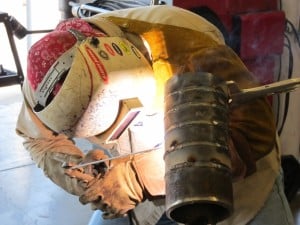Common Welding Processes
What exactly is Welding? Before we actually get into the description of the different welding processes it is important to understand exactly what welding is, The American Welding Society defines welding as:
“A materials joining process which produces coalescence of materials by heating them to suitable temperatures with or without the application of pressure or by the application of pressure alone and with or without the use of filler material”.
Whew….that’s a mouthful of complicated isn’t it? To put it in simpler terms for our topic – welding would be considered the joining of separate pieces of metal by using heat and additional filler metal in order to fuse the separate pieces together into one structure.
As you may know, there are hundreds of welding processes, but only four that are commonly used. These are Shielded Metal Arc Welding, commonly known as Stick, Gas Metal Arc Welding commonly known as MIG, Flux Cored Arc Welding (FCAW) and Gas Tungsten Arc Welding commonly known as TIG.
In honor of National Welding Month, we will be diving into these processes one by one. Up first is Shielded Metal Are Welding.
Shielded Metal Arc Welding– also referred to as “Stick”, “Stick Rod” or just plain Arc Welding.
This is one of the oldest electrically based welding processes still in use today. The stick welding process uses an electrode commonly called a “welding rod” that is composed of a solid metal core surrounded by a flux coating. The welder uses an electrode holder or “stinger” that holds the welding rod and provides electrical current to the welding rod. The welder uses the welding rod to strike an arc on the base metal. Once the arc is started the rod will burn causing the flux covering to generate the shielding gas and the filler metal will melt into the weld puddle. The welder then manipulates this weld puddle to perform the weld. This particular welding process does require some skill in order to produce good welds and can be used indoors or outdoors. Stick welding is rarely used in large fabrication shops due to the fact that it is slow and its inability to weld certain types of metals or alloys. It is used extensively in field welding due to its portability and versatility. The stick welding process is a good choice to learn first in that the skills developed form the basis of techniques that can be used in developing skills in the other welding processes.
Check back with us later to learn about the other common welding processes!
More on Welding:










